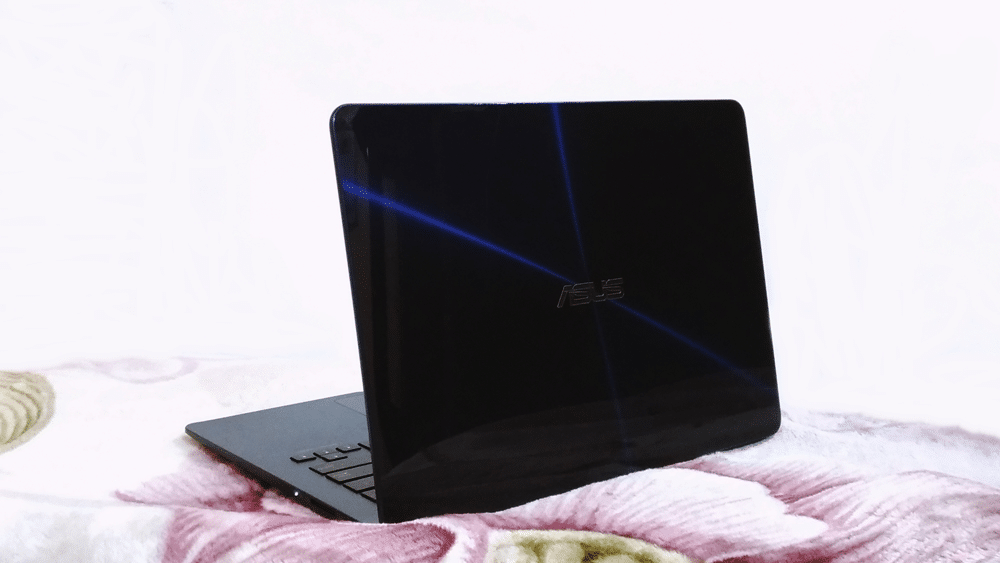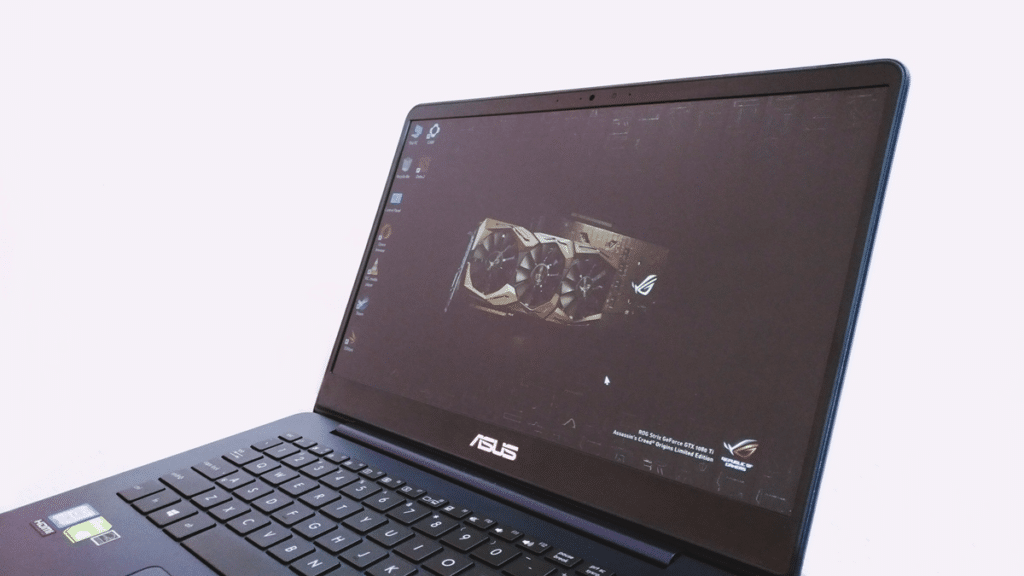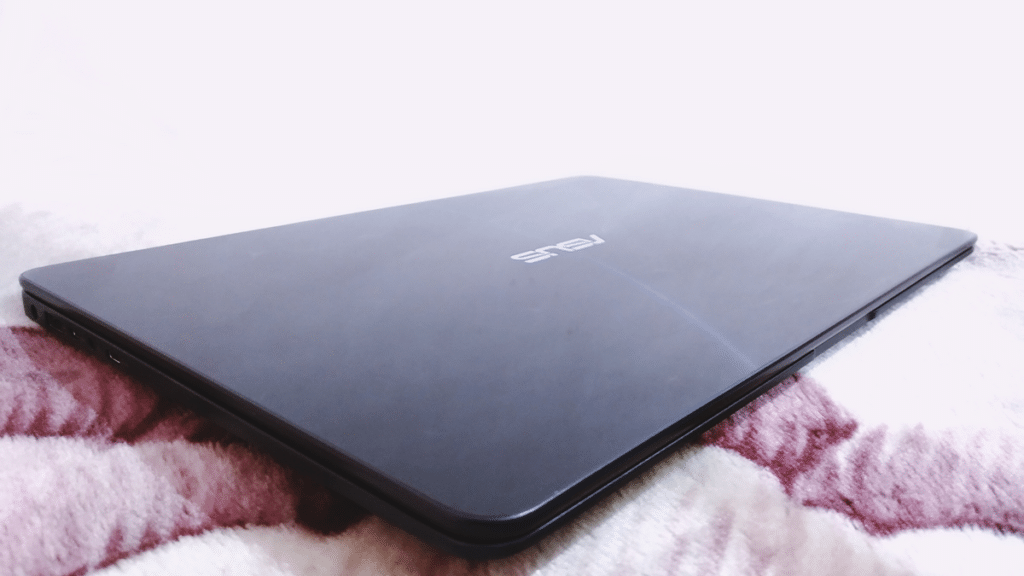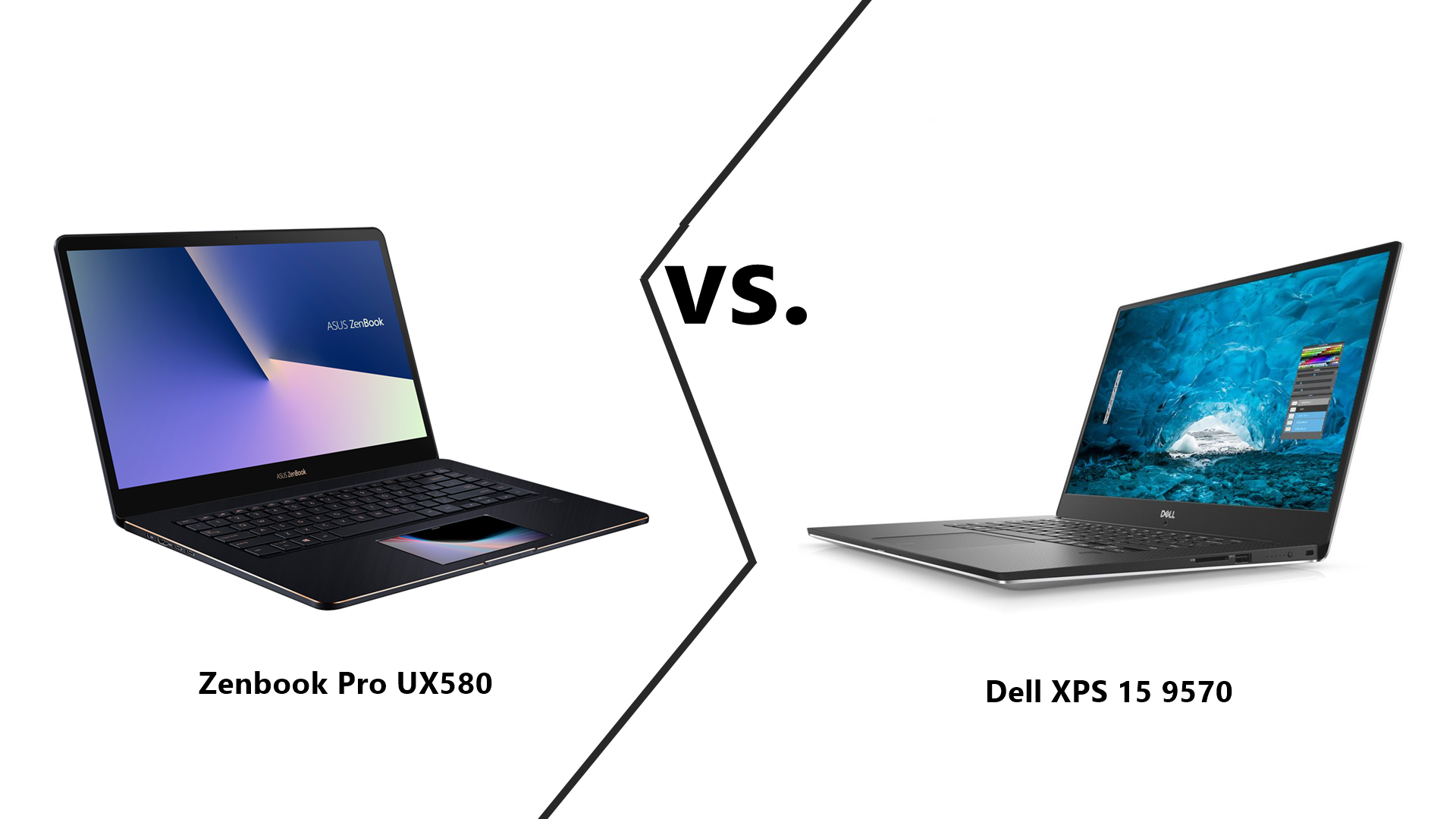ASUS Zenbook UX430UN Review – Slim And Powerful !
ASUS has refreshed the Zenbook UX430 with Intel’s latest 8th Gen Core Processors & even the old NVIDIA 940MX GPU has been dumped for a new & more powerful NVIDIA MX150. So, at first glance it might seem really similar to the Vivobook S15 that we reviewed earlier cause, it absolutely is but, this device has some significant advantages over the Vivobook & hence it also comes with a higher price tag. We have spent some time with the device & this is our ASUS Zenbook UX430UN Review.
Model Name | Specification | Price (INR) | Buy Here |
| Asus UX430UN – GV020T | (8th Gen i7-8550U/8GB/512GB/Windows 10/2GB Graphics) | 94,690 | Buy UX430UN i7 Model |
| ASUS UX430UN – GV069T | (i5-8250U/8GB/256GB/Windows 10 (64bit)/2GB Graphics) | 78,990 | Buy UX 430 UN i5 Model |
ASUS ZENBOOK UX430 SPECIFICATIONS

Dimensions: 32.4 cm x 22.5 cm x 1.59 cm
Display: 14 inch, 60Hz, 1920 x 1080 IPS LCD Display With 100% sRGB
Processor: Intel’s 14nm Kaby Lake-R Core i7-8550U (15W TDP, Boost upto 4.0 GHz, 8MB L3 Cache)
RAM: 8GB 1866 MHz DDR3 Memory
GPU: NVIDIA MX 150 (384 CUDA Cores)
VRAM: 2GB GDDR5
Storage: 512GB SATA3 SSD (HYNIX HFS512G39TND) (Around 475GB Usable)
Wi-Fi: 802.11 a/b/g/n/ac , 2×2
Bluetooth: Bluetooth v4.1
Ports: 1 x Type-C USB 3.1 (DisplayPort Supported), 1 x Type-A USB 3.1, 1 x USB 2.0, 1 x Micro HDMI, 1 x Combo 3.5mm Audio Jack, 1 x SD Card Reader
Audio: Dual 1.5W Down Facing Stereo Speakers
Webcam: 720P HD Webcam
Battery: 50Whrs, 3 Cells
Weight: 1.25 kg (2.76 pounds)
ASUS ZENBOOK UX430 DESIGN & BUILD QUALITY
The Zenbook UX430 has quite an eye-catching Design with a new kind of Glossy Material that ASUS calls the Nanoimprint Lithography Coating on the top. It looks like Glass but it isn’t & it’s a Transparent Glossy material instead to give an illusion of Glass. Yes, it would have been nice to see pure Glass but, it would make the top surface breakable. However, the coating can get scratches if you’re curious.
ASUS claims that there is a 14-inch Display sitting in a 13-inch Chassis & I can tell by looking at the actual device that, it is kinda true. It’s quite similar in size to the Zenbook UX360 that was a 13-inch device.
The hinge is well tuned & has a nice tension to it. You need to use two hands to open the laptop. So, it’s not one hand open-able. I don’t have any issues with that but, if you had this question, now you have your answer.
The Keyboard has a nice layout. The 1.4mm Key Travel feels Okay for an Ultrabook, better than what I expected in this kind of form factor so, it’s a nice Keyboard to type on. The keys also lit up White with three levels of Brightness to customize.
The Trackpad is pretty good. It uses Windows Precision Drivers & coupled with the Glass Surface, it has great tracking. It’s nice to see ASUS using Windows Precision Trackpads in more & more of their devices. The Button clicks are a little bit shallow and depending what kind of Trackpad Clicks are you used to, you may or may not like it.
ASUS ZENBOOK UX430 Review – Design and Build Quality continued…
Talking about the Fingerprint Scanner, it’s quite fast & snappy. I also found this one to be a little bit more accurate compared to the one on the Vivobook S15. Overall, I had a good experience while signing in using Windows Hello. It’s a good Scanner overall.

The Chassis is quite Solid with very minimal flex to it on the Keyboard area. Back is rock is solid however. If you want to dig inside, there are about Nine Screws on the back. Overall it’s a Solid Build Quality & it’s not a cheap device so, good Build Quality is what we expect.
Talking about Ports, it does come with a decent amount of Ports for an Ultrabook. So, on the left, we have a USB 3.1 Type-A Port, a Mini HDMI Port, a 3.5 mm Headphone & Microphone Combo Jack & a USB 3.1 Type-C port that also integrates the DisplayPort Support.
On the Right, we have a USB 2.0 Type-A Port & a SD Card slot & that’s literally all the ports available on board.
There is no Full Size HDMI or Full Size Ethernet Ports but, ASUS includes adapters for Mini HDMI to Full Size HDMI & USB Type-A to Ethernet in the box.
THE DISPLAY of ASUS ZENBOOK UX430

The Zenbook UX430 is rocking a 14″ IPS LCD Display & coupled with those Minimalistic Bezels it’s nice to look at. Color Accuracy is also great on this Laptop. So, the IPS Panel covers around 100% of the sRGB Color Gamut. Though, I don’t know the Adobe RGB values but, the Panel actually looks effectively better for things like Content Creation. So, if you’re into something like Photo or Video Editing, the Display on the UX430 is a far better choice compared to the Display on the Vivobook S15 that we reviewed earlier.
The Brightness is also a lot more compared to the Vivobook S15. So, again ASUS does not mention any Nits rating on their website but, according to me, it’s 300+ nits on the Zenbook UX430. This is also an Anti Glare panel so reflections should not be an issue if you want to use it outdoors.
The Display again ships with that warmer color tone that we’re seeing in all the new ASUS laptops. But, in this case, as the Color Accuracy is quite good, it’s not a huge deal. If you want though, there is an included software called ASUS Splendid where you can adjust the display to a cooler color tone. In my case, I dragged the settings to the coolest color tone available.
ASUS ZENBOOK UX430 PERFORMANCE
The Zenbook UX430UN has been refreshed with the latest 8th-gen Intel Core U-Series CPUs. These CPUs come with 4 Physical Cores & 8 Threads. Our review unit is running an i7-8550U with 8 Gigabytes of DDR4 RAM.
If you’re curious about Benchmarks, here is Geekbench Comparison with the GL553VE that was running the i7-7700HQ.
Coming to the real-life performance, the system feels Quick & Snappy. The i7-8550U is slightly faster in Single-core performance. However, compared to the old 7th Gen CPUs that only have Two cores, the new 8th Gen CPUs ship with Four cores instead. So, where the 8550U strikes are Multi-core Performance. That segment has seen a huge performance increase compared to the last gen 7500U.
So, people who want to do better Multi-core stuff like Photo or Video Editing in a form factor like this, the 8550U delivers a significantly better performance over its predecessor. If you’re curious about Video Editing speeds, then here is a chart to give you a rough idea about 4K 30FPS Video Editing.
However, this system is more suited for 1080P Edits compared to 4K being a 15W CPU. So, if you want to do 4K Edits, I’ll recommend at least a 45W Quad-core CPU.
Here another differentiator was the SSD speed. The UX430 comes with a 512 Gig M.2 SATA3 SSD. The Read Speeds are damn close to the Vivobook S15’s 128 Gig SSD but, the Write Speeds are a lot faster on this drive by about 300 MBPS so, Video Editing has slightly faster render times on this UX430. However, if you want to do Video Editing, I’ll recommend getting the 16GB RAM version instead.

The Fan Noise comes up pretty often while performing even moderately demanding tasks & while editing Videos or playing Games, it’s a bit loud. Not terrible & many people don’t care about stuff like that but, for some people it’s can be a bit annoying. So, that’s another thing you need to keep in mind.
There is a NVIDIA MX150 GPU for delivering the Graphical Horsepower & it has 2 Gigabytes of GDDR5 VRAM alongside. The performance of the MX150 is somewhere between the GTX 950M & GTX 960M.
Here is a 3DMark Comparison between the UX430UN & the ROG G501VW that are running the MX150 & GTX 960M respectively.
ASUS Zenbook UX430UN Review – Performance Section – Continued
If you want to game on it, you can play most of the popular games at 1080P 60 frames per second if you are playing on medium settings. At High settings, the average frame rate can fall down somewhere at 30 to 45 frames per second depending on the game.
More demanding games will run with comparatively less frame rates. So, the UX430 is designed for professionals but, it can handle lightweight gaming. But, don’t pick this laptop if your main intention is to play games on it.
Finally, it all comes down to Battery Life & this is a big reason why many people buy Laptops with U-series CPUs inside. So, ASUS claims around 9 hours of Battery Life out from that 50 Whrs Cell & by performing regular stuff like Web Browsing, Taking Notes, Watching some Youtube Videos etc. & I was getting around 7.5-8 hours of Battery Life out of it. So, it goes pretty close to the claims & the Battery life depends on what you’re doing on the device.
ASUS ZENBOOK UX430 AUDIO

There are two 1.5W Bottom Firing Speakers located on the Sides of the Laptop. Quality is better than I expected. Normally most of the Windows Ultrabook speakers are not so good but, these ones are pretty good. The clarity is nice, the Distortion is very minimal at higher volumes.
There is a little Bass in the speakers that I was not expecting. The Mids & Lows are nice & the Highs are kinda Okay. The loudness could have been higher but, that’s the nature of Thin & Light Ultrabooks. I kinda liked the speakers overall but, I would have appreciated a little bit more loudness while preserving the good quality.
The Audio Output via. Earphones are Good as expected & you can switch the audio in the ASUS AudioWizerd for various scenarios like Music, many movies, etc.
The Verdict of ASUS Zenbook UX430UN Review

The Zenbook UX430UN starts around ₹95990 in India (for the i7-8550U Model with 8GB RAM) & ₹81990 (for the i5-8250U Model with 8GB RAM & Integrated Graphics) and around $1099 in the US (for the i7-8550U Model with 16GB RAM).
So, this not a super cheap device to get & at this price point is the UX430UN a worthy purchase? Let’s have a look at the Pros & Cons.
ASUS Zenbook UX430UN Review – Pros
- Good Build Quality for the price
- Slim & Light form factor
- The Quadcore i7-8550U gives a nice performance increase compared to the 7500U Dual Core CPU in Multi-core tasks
- The new MX150 GPU is a nice improvement over the last gen GTX 940MX & it’s actually better than the 950M as well
- The Fingerprint Sensor is fast & accurate
- Good Battery life
- Good Audio Output
ASUS Zenbook UX430UN Review – Cons
- The 15W U-series CPUs do struggle while stressing the CPU for an extended period of time & it drops to its base clock speeds later on
- Fan Noise is loud at a well audible level while doing tasks like Video Editing & Gaming
- The 720 Webcam could have been improved
- There is no Thunderbolt 3 support which many users prefer in Ultrabooks
So according to me, if you’re looking for a Professional Grade laptop that is not super expensive, comes with capable & balanced hardware, has good battery life & also comes in a thin & light form factor while not compromising in build quality, the Zenbook UX430 is a good option.
If you want to bang on games on it, look for something that is more suited for gaming. Yes, those laptops won’t be as thin, light & professional looking as the UX430 but, those will have powerful 45W CPUs & better GPUs that comes handy in terms of gaming. I won’t pick this laptop if my main intention is to play games.
But, for people who want to use it for Professional Office Stuff, Photo Editing, Light Video Editing, Media Consumption & stuff like that, the UX430UN is a good option.
Okay, so that concludes our ASUS Zenbook UX430UN Review with the refreshed 8th Gen Kabylake-R CPU. If you have any questions, be sure to let us know in the comments section below & we’ll catch you with another Laptop review very soon.




